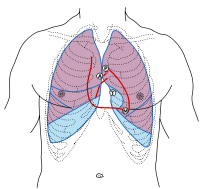
Photo from wikipedia
Prostacyclins are vasodilatory agents used in the treatment of pulmonary arterial hypertension. The direct effects of prostacyclins on right heart function are still not clarified. The aim of this study… Click to show full abstract
Prostacyclins are vasodilatory agents used in the treatment of pulmonary arterial hypertension. The direct effects of prostacyclins on right heart function are still not clarified. The aim of this study was to investigate the possible direct inotropic properties of clinical available prostacyclin mimetics in the normal and the pressure-overloaded human right atrium. Trabeculae from the right atrium were collected during surgery from chronic thromboembolic pulmonary hypertension (CTEPH) patients with pressure-overloaded right hearts, undergoing pulmonary thromboendarterectomy (n = 10) and from patients with normal right hearts operated by valve replacement or coronary bypass surgery (n = 9). The trabeculae were placed in an organ bath, continuously paced at 1 Hz. They were subjected to increasing concentrations of iloprost, treprostinil, epoprostenol, or MRE-269, followed by isoprenaline to elicit a reference inotropic response. The force of contraction was measured continuously. The expression of prostanoid receptors was explored through quantitative polymerase chain reaction (qPCR). Iloprost, treprostinil, epoprostenol, or MRE-269 did not alter force of contraction in any of the trabeculae. Isoprenaline showed a direct inotropic response in both trabeculae from the pressure-overloaded right atrium and from the normal right atrium. Control experiments on ventricular trabeculae from the pig failed to show an inotropic response to the prostacyclin mimetics. qPCR demonstrated varying expression of the different prostanoid receptors in the human atrium. In conclusion, prostacyclin mimetics did not increase the force of contraction of human atrial trabeculae from the normal or the pressure-overloaded right heart. These data suggest that prostacyclin mimetics have no direct inotropic effects in the human right atrium.
Journal Title: Pulmonary Circulation
Year Published: 2017
Link to full text (if available)
Share on Social Media: Sign Up to like & get
recommendations!